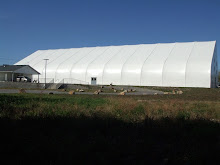If you read my last blog, you'll know that Zipper had decided that jump class was quite boring, thank-you-very-much. And he'd rather be doing something else.
This week I decided to be prepared. I knew that I might need to do some extra lead-in jumps to each problem if he was being draggy, and I brought very yummy treats too.
Well for whatever reason, Zip decided that he liked the class this week. Which is a good thing because his handler had to keep trying one of the sequences because she couldn't get it right, which meant that he repeated just that one sequence four or five times. But he was cheerful about it, which is good.
I've probably written this before, but in agility, the skills the dog learns to physically negotiate the obstacles are important. I've put in the basics on Zipper and he's confident on all the obstacles. He has lovely jumping form and is rapidly conquering the intricacies of weaves. Most importantly, he thinks agility is fun and it has become self-rewarding for him.
Though it's the foundation of what comes later, the dog skill part of the agility equation is just a tiny drop in the bucket of what we will need to learn to become a team. Zipper still needs to learn to read my hand and shoulder cues. I need to learn which cues work best for him and when to use them. Coming from handling a big dog, I've got to totally reset how I think about which crosses to put in where, what his line will be and how to shape it. Where do I need to be on the course in relation to Zipper's position in order to help him figure out what I want? Which hand should I use when? I must guard against stooping and bending over, a very bad habit that's easy to fall into when you have a little dog. Do I need a verbal directional? Or not? I've been training one but haven't yet tied it to jumps, only spins.
I'm learning that Zipper is right footed. That means he prefers to turn right rather than left and that I need to help him be more flexible on his left. Knowing that will also help me know how to run him; he'll probably turn tighter to the right than to the left, so I'll need extra turn space when I need him to go left than when the next obstacle is to the right.
And that's just the start. I usually estimate that it takes two years of actually trialling with a dog before you really start to become a team. Before you're a team, you can have a lot of success but it sometimes feels crunchy or awkward. After you become a team, for the most part you and the dog just KNOW what you're going to do, what works and what doesn't, and when you run, you are extensions of each other, thinking and moving as one.
It's no wonder that newbies to agility have a very tough time with their first dog. This sport is incredibly fun and rewarding, but easy it is not! It looks easy and effortless, especially when done right. But there's an awful lot of training that goes into that looking easy part. New handlers are having to both learn how to train their dog for the skills the dog needs *and* how to learn the separate skills they need. Here I am, on my third agility dog, and I've got to work through all these things too. I have a bit more on the ball than the true newbies on how to train those basic skills, but this biggest part of the puzzle, the handling game, is something I have to struggle with along with everybody else. Because each dog is different and there's always something that may work better with this dog too.
So I'm grateful to my little 10# dog for putting up with me stumbling around last night trying one cross, then another, then yet another. Each time he showed me what worked for him and what did not. Because at the same time I'm training him, he's training me.
Friday, June 20, 2008
Jump Class update
Subscribe to:
Post Comments (Atom)




No comments:
Post a Comment